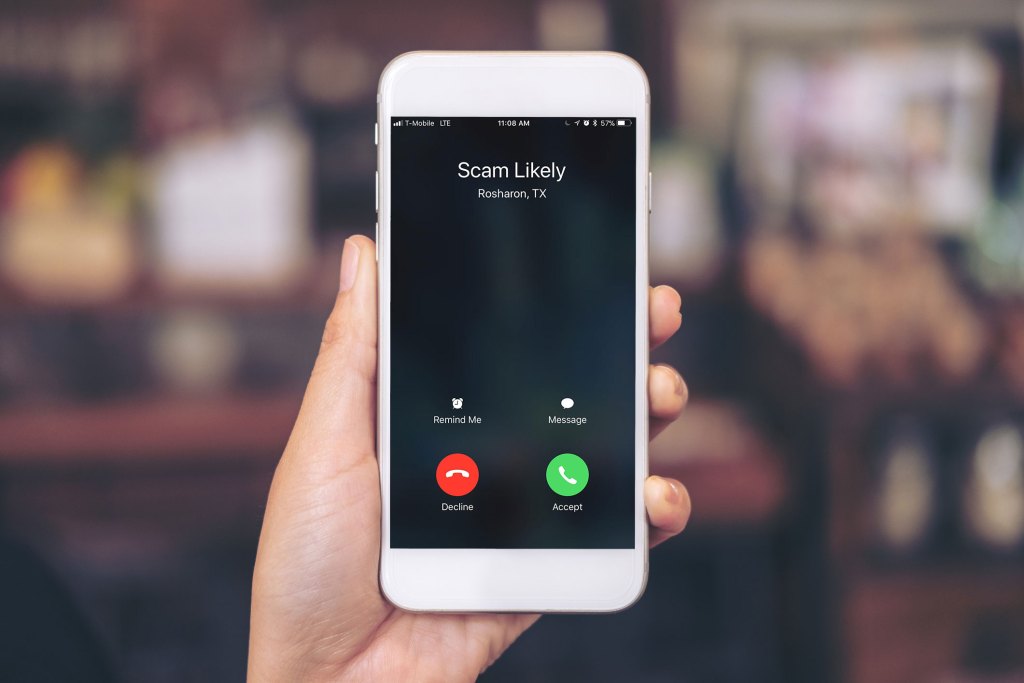How To Block Scam Likely Calls: A Must-Read Guide
Many people have reached out to us wondering how to block Scam Likely calls – and we responded below. The annoying name that pops up on your smartphone's Caller ID is not a company or brand, like some of you may think. Scam Likely is a warning from your service provider that the caller may be harmful to you.
These scam likely calls can be anything from a telemarketer to serious attempts to steal your information and defraud you. Very important: keep in mind that blocking Scam Likely calls is different than knowing how to stop scam calls. Let's explain.
Scam Detectors Most Trusted Websites in Online Security
- Guard.io (100): Surf the web safely. Clean up your browser, remove maliscious extensions and check for privacy violations.
- Incogni.com (100): Delete your personal data from the internet and protect against scams and identity theft.
- ExpressVPN (100) Stay secure and anonymous online - Best VPN Out There
- IPVansish (100) Fast VPN to stay safe and secure online with multiple discount plans.
Let us take a quick look at what the Scam Likely labeling technology is and how the big four wireless service providers use it to protect you from unsolicited calls. Here it is:

How Is a Call Labeled “Scam Likely”?
The process of detecting scam calls is complicated. Many factors go into determining whether or not a recipient wants a ring. Those factors are compiled into tremendously substantial data sets that need to be analyzed in real-time (i.e., the scammers call you) using algorithms to find anomalous calls.
However, not all algorithms are created equal, and the less refined ones that look at smaller sets of data still allow some scammers through. Also, to further muddy up the waters, sometimes legitimate callers wind up on the scammer's list, and it takes time to remove them.
Here are what the big four are doing to improve their protections.
AT&T
Starting in 2019, AT&T began implementing two new standards to help weed out scam callers. The first is STIR (Secure Telephone Identity Revisited) is a protocol that certifies calls. SHAKEN (Signature-based Handling of Asserted information using tokens) is the other. It verifies the caller is allowed to use the phone number they are calling from. Together, these standards work to help stop calls from spoofed or faked phone numbers.
AT&T also offers a free app to its customers called “Call Protect.” It blocks robocalls and, as of the middle of 2018, labeled more than 429 million spam calls and blocked about 365 million fraudulent calls. For more protection, you can spend $3.99 a month and upgrade to “Call Protect Plus.” You will get access to Reverse Number Lookup, Enhanced Caller ID, and Custom Call Controls.
T-Mobile
T-Mobile was one of the first major service providers to use the STIR and SHAKEN protocols. In January 2018, they started rolling out technology nicknamed “Caller Verified.” For each phone call on the T-Mobile network, an algorithm runs that number through a database of numbers that have been identified as scammers. Should that number match an alleged scammer, you will be warned in the Caller ID with a “Scam Likely” label. Paired with its “Scam Block” feature, which allows you to block scammers once and for all, T-Mobile is working hard to protect you.
The technology is not perfect, though. T-Mobile has provided a website where callers can submit corrections for the scam call database.
Verizon
To combat unsolicited calls, Verizon is continuously working on its list of over 300 million numbers believed to belong to robocalls and spammers. That list is being used in conjunction with a free call-blocking and spam-alerting tool which Verizon started giving customers access to in March of 2019. As with T-Mobile, Verizon has also given users a way to report false positives to improve their list.
Sprint
Sprint is using STIR and SHAKEN to offer both a free and a premium service for stopping unsolicited calls. The free service is called “Sprint Call Screener Basic.” It's identifying the highest risk spam callers and allows you to block them.
For $2.99 a month, you can get access to “Sprint Call Screener Plus.” This premium version has several features, including showing callers and texters information even when they are not listed in your contacts and id's and blocks lower-risk nuisance calls.
Now, let's look into why you are reading this article.

How Do You Block All Scam Likely Calls?
Now that you know what Scam Llikeikely calls are and what the big four wireless service providers are doing to protect you from them, it is time to learn how to block them for yourself. For each provider, we have tried to identify the most convenient way to block calls.
T-Mobile
As useful as these features and notifications are, they are still annoying to receive over and over. Fortunately, T-Mobile has come up with an easy way for you to block all scam likely calls. All you need is your iPhone or Android's phone app and the following numeric codes:
- #662# – turns on Scam Block
#632# – turns off Scam Block
#787# – check if Scam Block is on
For example, to turn T-Mobile's Scam Block on and block all calls from their scammer's database, all you need to do is dial “#662” and hit send as if you were calling an actual number. You can also do the same with the other two codes in the list to access their functions.
Verizon
Postpaid Verizon customers, depending on device compatibility, can get access to “Call Filter.” The free version has spam detection and blocking of high-risk calls and the ability to report numbers. All postpaid Verizon customers are automatically enrolled.
You can also pay for the premium version “Call Filter Plus.” For $2.99 a month (again, depending on device compatibility), additional features such as Caller ID, personal block list, personal spam list, spam lookup, and risk meter are available. All of these tools are valuable in the fight against scam likely calls.
AT&T
AT&T's customers who want to block scam likely calls are well-protected. They now have a free service called “AT&T Call Protect.” All eligible customers are automatically enrolled, and you can opt-out if you want to. In addition to scam likely call warnings and automatic blocking of fraud calls, you will get a personal block list, unknown callers blocking, and spam risk blocking.
Members of the premium version (which costs $3.99 a month) also get enhanced Caller ID, reverse number lookup, and custom call controls. Everyone can also go to the AT&T website to report unsolicited calls and texts, which will help them improve their database.
Sprint
As mentioned previously in this article, the “Sprint Call Screener Basic” and “Sprint Call Screener Pus” services are how Sprint chooses to alert you and allow you to block scam likely calls.
Once you know a number belongs to a scammer, telemarketer, or robocaller, you have a couple of options to block them. You can go to your Sprint account and block them using “Limits and Permissions,” or you can do it from your Android phone. On your phone, there will be a three-button menu that has the option to block numbers.
Unfortunately, not everyone is eligible for some of the service providers to take advantage of their scam likely phone call protections. In that case, both the iOS store and Google Play Store have options you can download. You will likely have to pay some monthly fee, but it is worth it to stop robocalls and the like from blowing up your phone.
As an alternative to all this text, watch the video below to see how to block Scam Likely calls:
How to Stop Scam Likely Calls: Is There Anything Else To Know?
While the tools the big four service providers offer are generally excellent, you can do more to protect yourself. First, you should register for the National Do Not Call Registry. It probably will not stop robocalls and other scammers, but it should stop real companies from making unsolicited sales calls.
Next, report any unwanted calls and texts. Please report them to your service provider to add to their database and report them to the FTC (Federal Trade Commission, see below the links for reporting), so there will hopefully be consequences.
Another critical task is to educate yourself. Read the news, check out your service provider's and/or the FTC's website, watch your emails, etc. Once you hear of a scam, make sure you share the information with others. These scammers thrive on ignorance.
Be More Private
Also, never answer a stranger's questions, especially ones designed to elicit sensitive personal information. If it seems necessary, ask to call back later. Make sure you look up the number and do not just blindly use the number they gave you.
Probably the best way to stop annoying and fraudulent phone calls, though, is to get a new number. Seriously think about whom you give it out to in the future. Many people automatically share their numbers when asked.
It may seem harmless to give your number for a rewards card or enter an online contest, just to name a couple, but many times your information is put on a list and later sold to someone else. If you must give out your number, say a website you are signing up for and read the fine print. Also, opt-out if there is an option to share information with their partners.
Technology is improving all the time, but it is not foolproof. A little common sense now may save you from trouble in the future.
Scam Calls: How To Report
Warn your family and friends about this article by sharing it on social media using the buttons provided. You can also officially report the scammers to the Federal Trade Commission using the link below:
How To Protect Yourself More
If you want to be the first to find out the most notorious scams every week, feel free to subscribe to the Scam Detector newsletter here. You'll receive periodic emails – we promise not to spam. Meanwhile, educate yourself with some other fraud-related articles right under this paragraph, so that you can protect yourself in many other aspects and niches. Last but not least, use the Comments section below to expose other scammers.
Here are some must-reads for the end:
Phone Scams: A Full List
How To Tell If Someone Is Scamming You Online
If You Receive a Call From Your Own Number Do Not Answer
Verify a website below
Are you just about to make a purchase online? See if the website is legit with our validator:
vldtr®


TOP 4 MUST-WATCH FRAUD PREVENTION VIDEOS
1. Top 5 Amazon Scams in 2024 2. Top 5 PayPal Scams in 2024 3. How To Spot a Scam Email in 2024
- Latest Posts by Selma Hrynchuk
-
Compromised Credit Card Scam
- -
Fake Google Chrome Update
- -
Facebook Privacy Notice Hoax
- All Posts














I’m interested to get your emails of scams every week.